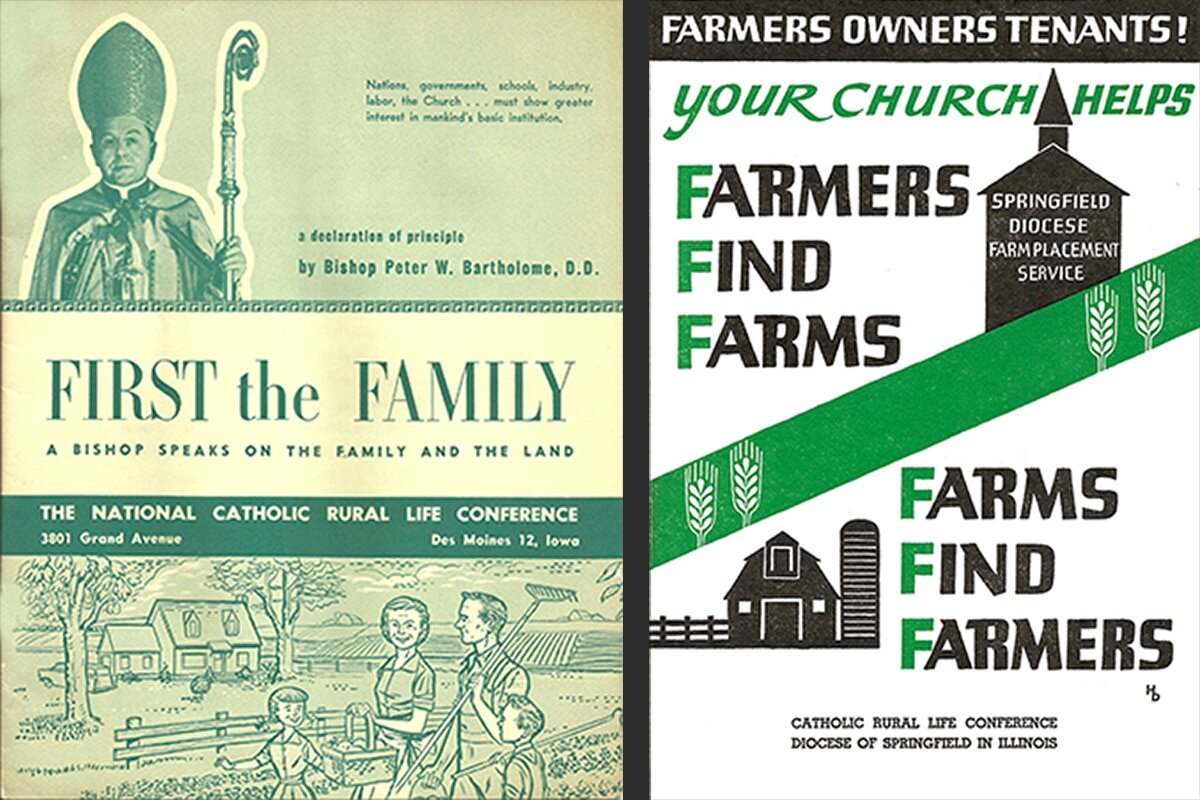A Response to ‘The Greening of America, Catholic Style'
There is a fascinating article co-authored by Christopher Hamlin and John T. McGreevy, both of the University of Notre Dame, entitled, “The Greening of America, Catholic Style: 1930-1950.”[note]The article focuses on three aspects of the NCRLC. First is its ideology, as a "third way," a distributist alternative to socialism and capitalism. Second is the attempt to foster sustainable agricultural technologies by creating communitarian institutions in which the parish priest was central and by bringing an agrarian curriculum into Catholic higher education. Third is the attempt to ground this orientation toward sustainability in a distinctly Catholic nature spirituality.[/note] It chronicles the rise and fall of the “green revolution” philosophy advocated by the National Catholic Rural Life Conference during much of its peak years.[note]According to the author, "It was a profoundly different vision from the input-intensive agriculture which that term would come to signify in the 1950s and 1960s."[/note] It is a compelling narrative, both for its depth and comprehensiveness, and is an impressive display of historical analysis.Hamlin and McGreevy are among the few in contemporary Catholic intellectual circles who seemed to have noticed that there was, in fact, a robust effort on the part of many to bring Catholic intellectual tradition, specifically the social tradition, to bear upon the circumstances of Catholic rural life. The absence of a serious account of these efforts is a curious lacuna in historical scholarship, they note. I applaud their efforts both in recognizing the gap and seeking to begin to close it.They point to a number of causes that signaled the waning of NCRLC’s influence in rural matters: the ever-mutating and therefore diffuseness of its mission, an ambiguous relation to a Catholic hierarchy “little interested in rural matters and ambivalent toward that mission,” and a lack of adequate mechanisms for translating advice into action. “More decisively,” they noted, “its views were antithetical to the dominant paradigm of American agricultural policy.” In the end they do not mince words. “Clearly the Conference did not transform rural America.” And add, “Not only did the [NCRLC’s] green revolution fail to take off, it left hardly a memorial of its failure.”What occupies Hamlin and McGreevy, in other words, was not so much the movement’s rise and demise as the remarkable invisibility of the organization, dead or alive, among Catholic social historians. They challenge their colleagues to create a more inclusive (and therefore accurate) account of religiously motivated environmentalism in America, especially Catholic America.While it’s satisfying enough to read their rather extensive survey of the various elements of the movement in its heyday, the gem of their remarks appears in the penultimate sentence of the essay.
Recognition of a longer history of Catholic ... engagement with the issues of environmental quality can perhaps do something to challenge the image of religious environmentalism as an afterthought rather than a an essential component of a cosmology (as Thomas Aquinas certainly recognized and most anthropologists would acknowledge).
There you have it: the central tenet of the green revolution, “Catholic style.” The revolution was rooted, as was virtually every articulation of social norms espoused by Leo XIII and his successors, in a realist philosophy of nature, or cosmology, of St. Thomas Aquinas.In other words, classical Thomism situated its social agenda within a broader philosophical agenda about all of reality. They insisted, among other things, that the native habitat of the human person as an embodied, intellectual creature is the material cosmos of created natures, intelligently ordered by God and intelligibly grasped by man, a nexus of which constitutes the natural environment of the human person as such.The entire hierarchy of being, from the lowliest creature up to God, was permeated by a Provident intelligence that supplied the necessary connections between lower creation and its grace-filled care. The well-ordered farm, more importantly the well-ordered farmer, reflected the natural law of a prudential stewardship, not as some despot over untamed wilderness nor as some demagogue over an otherwise meaningless order of causality. Rather, the rational creature, St. Thomas insisted, participates in the eternal law of God’s creative action, and this participation is what is known as “the natural law.” The prudent steward inhabited a provident order of reality; an imago amidst the vestigia.Any exhortation to a moral assessment of one’s activities, including agriculture, was set against this horizon of an intelligible order. Agriculture, specifically, was a “co-operative art,” St. Thomas insisted, because its tasks were ineluctably yoked to the intelligible forces of nature itself. Like the teacher who guides the natural desire to know on the part of the student, or the doctor who capitalizes on the natural desire to live, the farmer labors with nature’s creative forces and coaxes from the earth the fruits she is destined to yield. His practical craft was distinct from that of the sculptor, who works to create what is first only in the mind. Instead one speaks of crop “yield” and animal “husbandry,” pointing to the fundamentally collaborative status of the farmer before the earth.As such, the craft of farming could never be rightly conducted in isolation from reality; nor, for that matter, from one’s neighbor. As both an embodied, social being, human action extended to the lowest levels of reality and the furthest reaches of community. The mandate to till and keep the earth was indeed universal, not so much as diffuse, and the consistent message throughout the years of efforts pointed to the centrality of this mission within the NCRLC. Such a realist cosmology supplied the essential backbone of its efforts to serve the rural population, because such a realism was the nerve center of virtually every aspect of the Church’s social agenda. To the extent that it is taught today, it supplies still the necessary principles for the ongoing renewal of such efforts. To the extent that it is ignored today, the social teaching often mutates from a species of prudential reasoning to mere exhortation.Which brings me to the point about the gap concerning NCRLC’s recognition and accomplishments. Hamlin and McGreevy point to a combination of elements within American Catholic cultural history that contributes to the dénouement of the NCRLC. I would like to add to that list and include the eclipse of an authentic, realist philosophy of nature in the intellectual landscape of Catholic educational programs.In the traditional curriculum of Catholic philosophy, the general subject of the philosophy of nature was further divided into cosmology and psychology, or a study of inanimate and animated creatures. (Natural theology, which treated the subject of God’s existence, was considered a third dimension.) Together these courses would have provided, at least in theory, both an account of the human person, but also (and this was essential) an account of the native habitat of that same human being—namely, the created world as intelligently ordered by God. In the realist landscape of Thomist thought, the human person was always set within the broader framework of an intelligible order of things, the existence of which was sustained by God as both the first cause and its end. The “green revolution,” Catholic style, would have been constructed upon an affirmation of this order of things and our fundamental responsibility within it. The green revolution was the social expression of a more comprehensive green Thomism. Or as Hamline and McGreevy put it, stewardship was an extension of cosmology.Over time, with the decreasing presence of philosophy in Catholic undergraduate formation in general, and Thomism specifically, philosophical psychology and philosophical cosmology disappeared from the tool kit of Catholics generally. The net result is something like we often find in our present circumstances. If there is a course that treats of the human person in the average Catholic college curriculum, it is most likely the “philosophy of the human person,” and deals with debates on post-Cartesian terms; that is, extensive energy is spent considering (and defending?) the hylemorphic notion of the person, a notion still so central to the Catholic view of the person.But the hylemorphic notion of the person was not, in classic Thomism, a “philosophy of the human person” strictly speaking. It was, instead, the focused application of a more general philosophy of nature to the question of the human person. The human person, in this analysis, is less the odd exception in an order of reality that is otherwise mechanical/material/meaningless. Instead, the human person was considered within a divinely arranged cosmos.It would not have been the stretch then that it seems to be now to move from a consideration of the human person among embodied creatures, to the responsibility within creation that is incumbent with this privileged status.This waning of a realist tradition would account, at least in part, both for the difficulty of Catholics to engage environmentalism in a distinctly Catholic manner today and the historical invisibility of the NCRLC’s efforts to raise those concerns. It is not so much about the failure of the NCRLC as it is the increasing color blindness concerning realist, Thomistic thought.In conclusion, if I have one reservation about Hamlin and McGreevy’s overall work, it would concern their predilection for eulogy. For what are no doubt self-serving reasons, I do not wish to characterize the NCRLC’s project as moribund. That it has not achieved what it often aspired to is a constant feature of every Catholic, socially conscious program this side of the eschaton. That it remains committed to the mission of serving the rural communities through the Church’s faith in Jesus Christ remains a central, animating conviction. And though historians may point to an era of prominence that the organization does not enjoy at the moment, “there lives the dearest, freshest, deep down things.” God’s creation remains so terribly beautiful; the mission to till it and keep it endures; we continue to work, waiting in joyful hope for the renewal of the face of His earth.Originally published in Catholic Rural Life.

